Business Finance Case Study: Costing, Budgeting, and Variance Analysis
VerifiedAdded on 2022/12/14
|13
|2563
|380
Case Study
AI Summary
This case study examines key concepts in business finance, including cost classification (fixed, variable, and semi-variable), break-even analysis, and the importance of contribution per unit. It delves into marginal and absorption costing methods, illustrating their application through income statements. The case study also explores the role of budgets in controlling business operations, detailing variance calculations for direct materials, labor, and overheads. Furthermore, it covers the preparation of budgets, emphasizing the significance of both fixed and variable overhead budgets, and direct labor budgets. The solution provides a comprehensive understanding of financial management principles essential for effective decision-making.
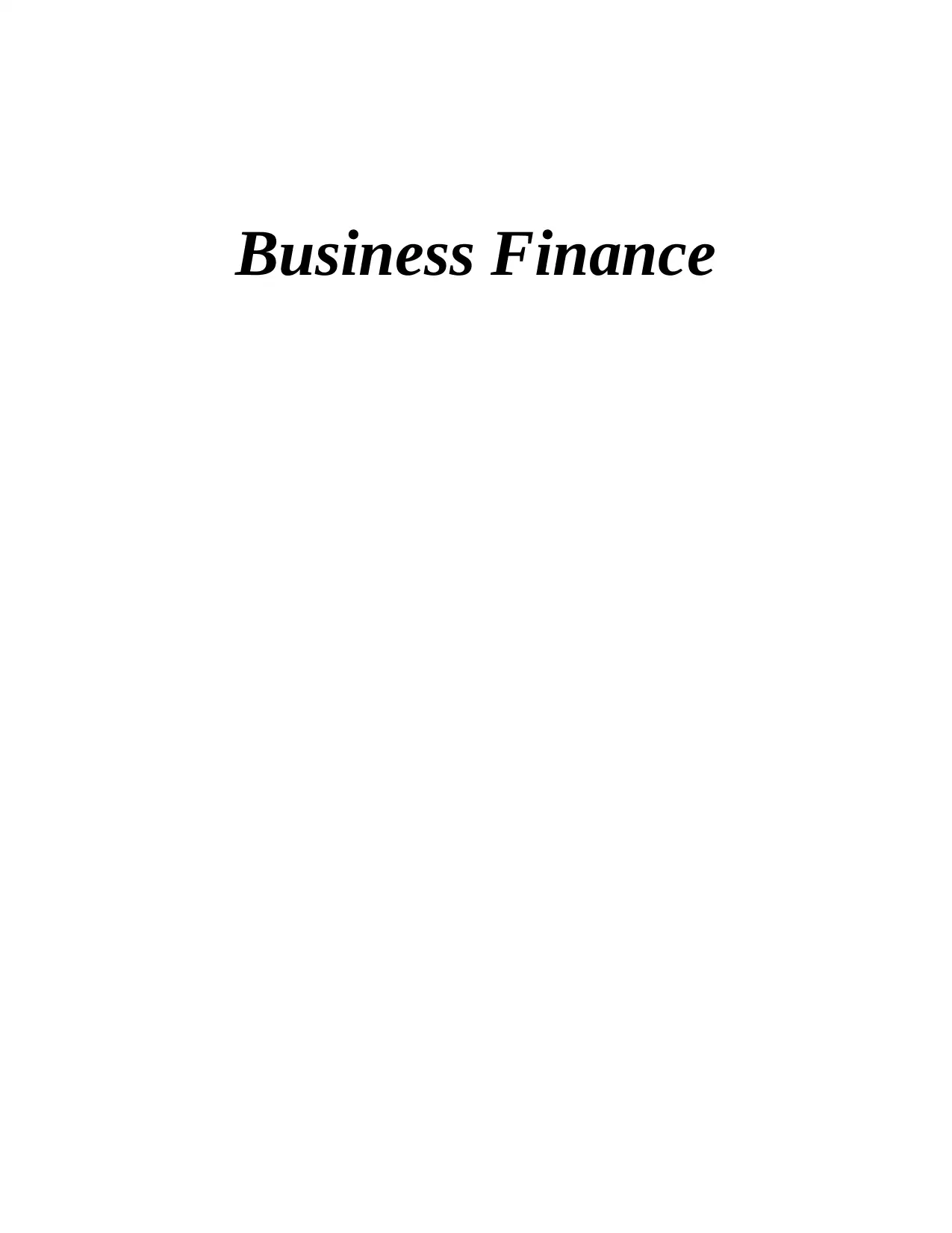
Business Finance
Paraphrase This Document
Need a fresh take? Get an instant paraphrase of this document with our AI Paraphraser

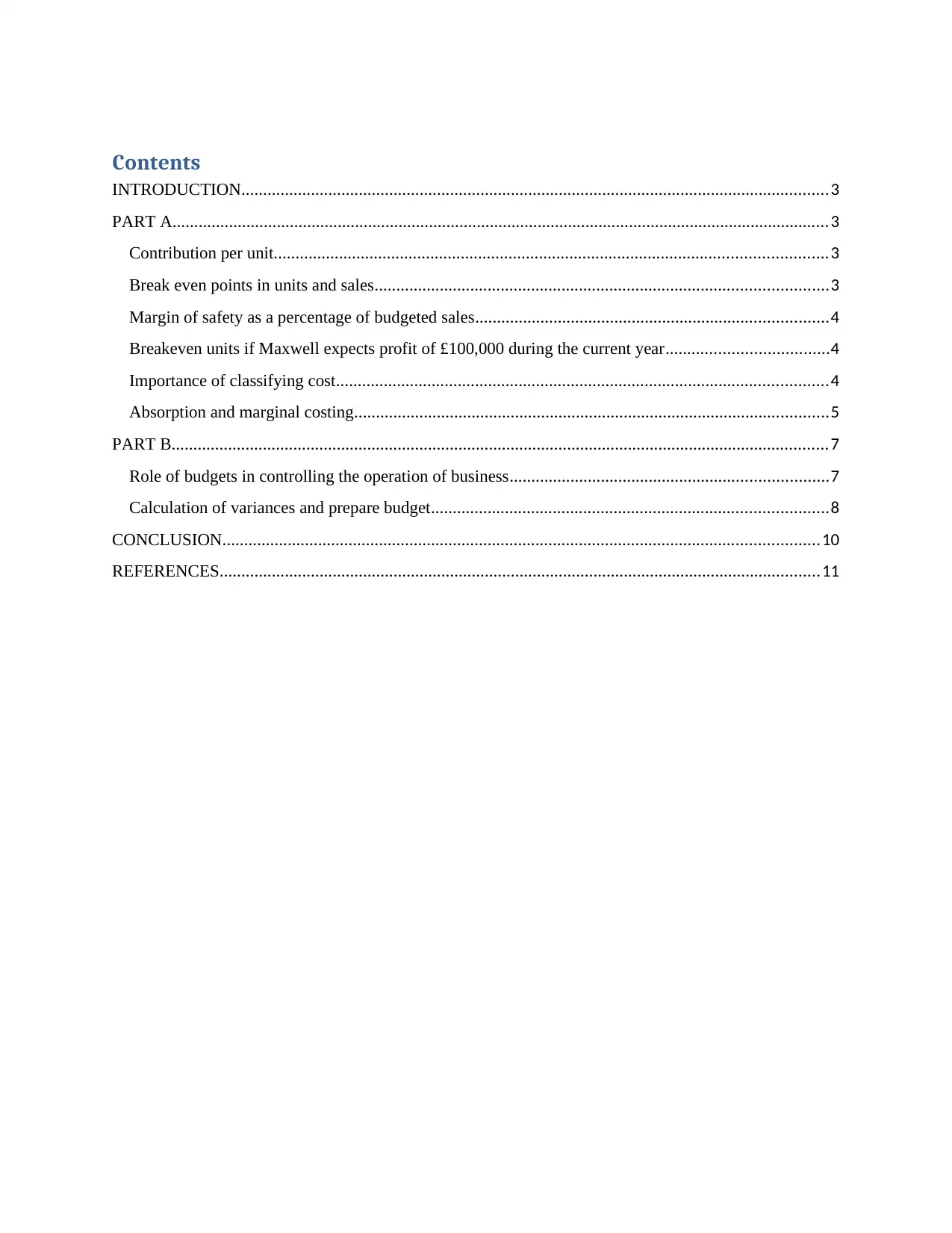
Contents
INTRODUCTION.......................................................................................................................................3
PART A.......................................................................................................................................................3
Contribution per unit...............................................................................................................................3
Break even points in units and sales........................................................................................................3
Margin of safety as a percentage of budgeted sales.................................................................................4
Breakeven units if Maxwell expects profit of £100,000 during the current year.....................................4
Importance of classifying cost.................................................................................................................4
Absorption and marginal costing.............................................................................................................5
PART B.......................................................................................................................................................7
Role of budgets in controlling the operation of business.........................................................................7
Calculation of variances and prepare budget...........................................................................................8
CONCLUSION.........................................................................................................................................10
REFERENCES..........................................................................................................................................11
INTRODUCTION.......................................................................................................................................3
PART A.......................................................................................................................................................3
Contribution per unit...............................................................................................................................3
Break even points in units and sales........................................................................................................3
Margin of safety as a percentage of budgeted sales.................................................................................4
Breakeven units if Maxwell expects profit of £100,000 during the current year.....................................4
Importance of classifying cost.................................................................................................................4
Absorption and marginal costing.............................................................................................................5
PART B.......................................................................................................................................................7
Role of budgets in controlling the operation of business.........................................................................7
Calculation of variances and prepare budget...........................................................................................8
CONCLUSION.........................................................................................................................................10
REFERENCES..........................................................................................................................................11
⊘ This is a preview!⊘
Do you want full access?
Subscribe today to unlock all pages.

Trusted by 1+ million students worldwide

INTRODUCTION
Finance refers to the administration of money and the acquisition of assets. Finance is a
board concept that refers to operations involving finance, equity, finance, financial markets,
assets, and acquisitions. The term "business financing" refers to the use of funds and credit in a
company (Hong, Karolyi and Scheinkman, 2020). This also aids in the management of financial
assets in order to increase the profitability of the company when analyzing financial reports
(profit and loss accounts, balance sheets and cash flow statements). It is not only sustaining need
but also effective requirement of corporation. It is most essential element that is required to
attention and follows procurement sources on its administration, investment that forced in this
conduct identified as the finance committee. In this report consist of contribution, margin of
safety, break even and importance of different cost. Along with, mention about the role of
budgets in controlling operation of an entity.
PART A
Contribution per unit
Particulars Amount (units)
Sales 100
Less: Variable cost
Direct Material 45
Direct Labor 30
Contribution 25
Break even points in units and sales
Breakeven point (in units): Fixed cost / Sales – variable
= 125000 / 25
= 5000 units
Finance refers to the administration of money and the acquisition of assets. Finance is a
board concept that refers to operations involving finance, equity, finance, financial markets,
assets, and acquisitions. The term "business financing" refers to the use of funds and credit in a
company (Hong, Karolyi and Scheinkman, 2020). This also aids in the management of financial
assets in order to increase the profitability of the company when analyzing financial reports
(profit and loss accounts, balance sheets and cash flow statements). It is not only sustaining need
but also effective requirement of corporation. It is most essential element that is required to
attention and follows procurement sources on its administration, investment that forced in this
conduct identified as the finance committee. In this report consist of contribution, margin of
safety, break even and importance of different cost. Along with, mention about the role of
budgets in controlling operation of an entity.
PART A
Contribution per unit
Particulars Amount (units)
Sales 100
Less: Variable cost
Direct Material 45
Direct Labor 30
Contribution 25
Break even points in units and sales
Breakeven point (in units): Fixed cost / Sales – variable
= 125000 / 25
= 5000 units
Paraphrase This Document
Need a fresh take? Get an instant paraphrase of this document with our AI Paraphraser
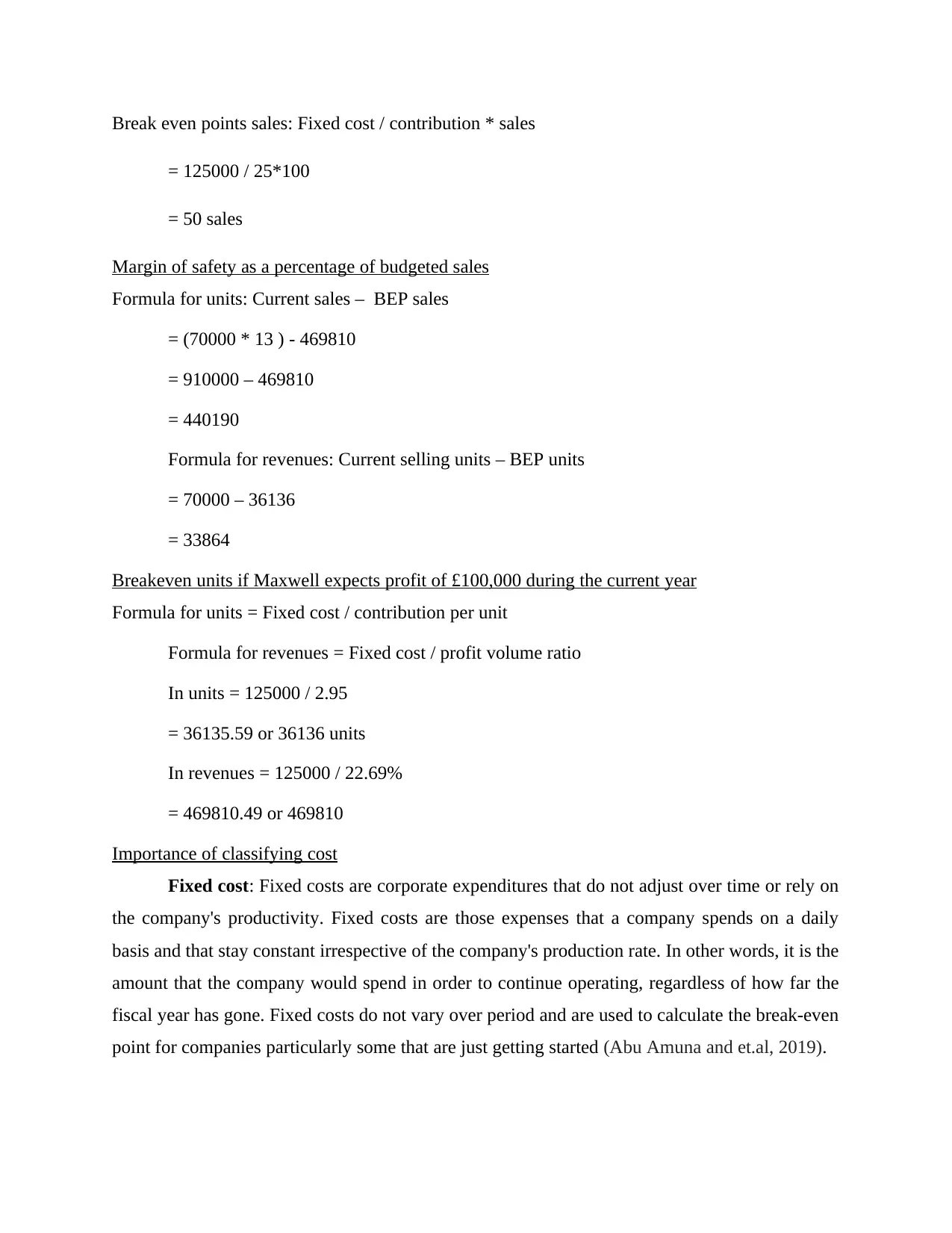
Break even points sales: Fixed cost / contribution * sales
= 125000 / 25*100
= 50 sales
Margin of safety as a percentage of budgeted sales
Formula for units: Current sales – BEP sales
= (70000 * 13 ) - 469810
= 910000 – 469810
= 440190
Formula for revenues: Current selling units – BEP units
= 70000 – 36136
= 33864
Breakeven units if Maxwell expects profit of £100,000 during the current year
Formula for units = Fixed cost / contribution per unit
Formula for revenues = Fixed cost / profit volume ratio
In units = 125000 / 2.95
= 36135.59 or 36136 units
In revenues = 125000 / 22.69%
= 469810.49 or 469810
Importance of classifying cost
Fixed cost: Fixed costs are corporate expenditures that do not adjust over time or rely on
the company's productivity. Fixed costs are those expenses that a company spends on a daily
basis and that stay constant irrespective of the company's production rate. In other words, it is the
amount that the company would spend in order to continue operating, regardless of how far the
fiscal year has gone. Fixed costs do not vary over period and are used to calculate the break-even
point for companies particularly some that are just getting started (Abu Amuna and et.al, 2019).
= 125000 / 25*100
= 50 sales
Margin of safety as a percentage of budgeted sales
Formula for units: Current sales – BEP sales
= (70000 * 13 ) - 469810
= 910000 – 469810
= 440190
Formula for revenues: Current selling units – BEP units
= 70000 – 36136
= 33864
Breakeven units if Maxwell expects profit of £100,000 during the current year
Formula for units = Fixed cost / contribution per unit
Formula for revenues = Fixed cost / profit volume ratio
In units = 125000 / 2.95
= 36135.59 or 36136 units
In revenues = 125000 / 22.69%
= 469810.49 or 469810
Importance of classifying cost
Fixed cost: Fixed costs are corporate expenditures that do not adjust over time or rely on
the company's productivity. Fixed costs are those expenses that a company spends on a daily
basis and that stay constant irrespective of the company's production rate. In other words, it is the
amount that the company would spend in order to continue operating, regardless of how far the
fiscal year has gone. Fixed costs do not vary over period and are used to calculate the break-even
point for companies particularly some that are just getting started (Abu Amuna and et.al, 2019).
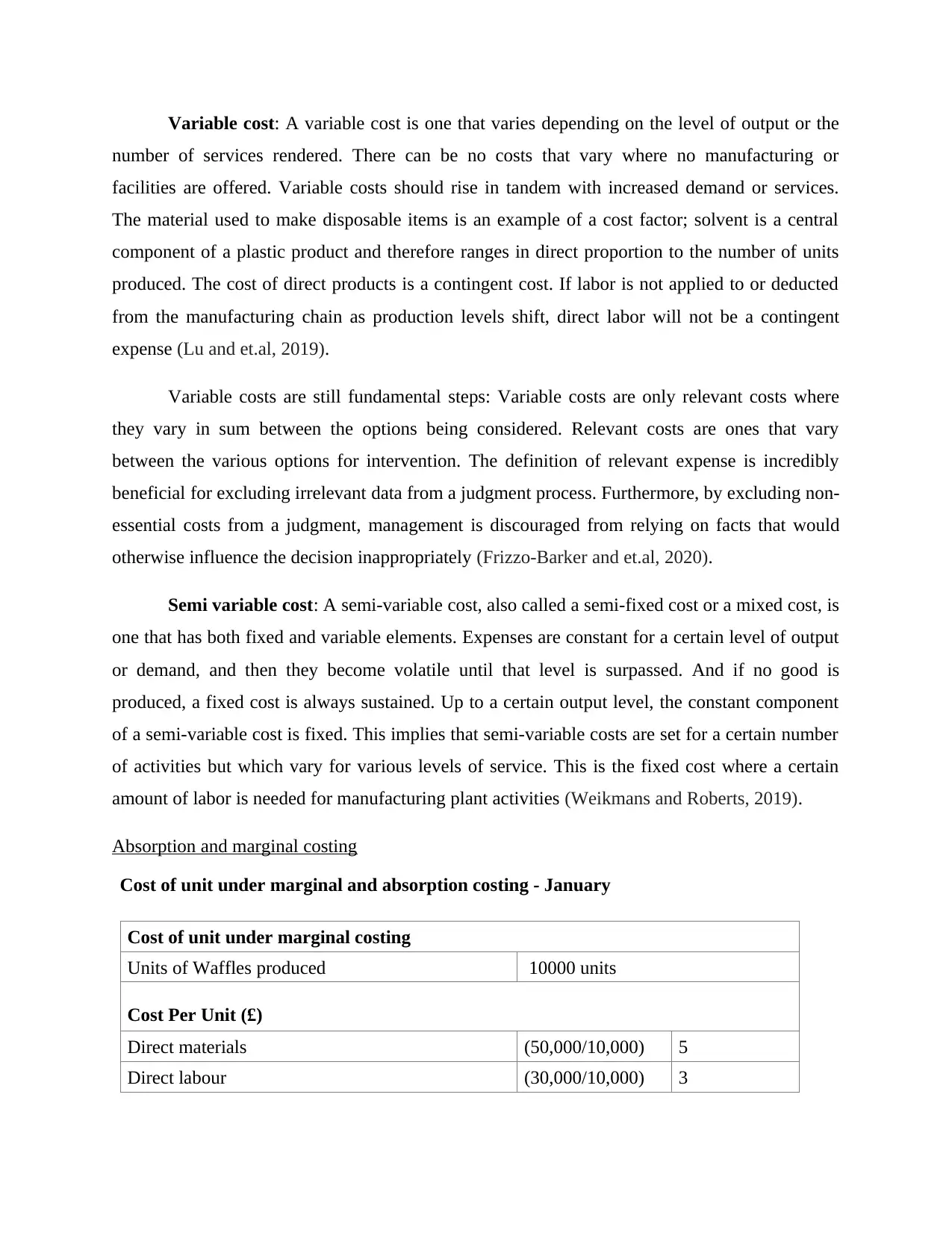
Variable cost: A variable cost is one that varies depending on the level of output or the
number of services rendered. There can be no costs that vary where no manufacturing or
facilities are offered. Variable costs should rise in tandem with increased demand or services.
The material used to make disposable items is an example of a cost factor; solvent is a central
component of a plastic product and therefore ranges in direct proportion to the number of units
produced. The cost of direct products is a contingent cost. If labor is not applied to or deducted
from the manufacturing chain as production levels shift, direct labor will not be a contingent
expense (Lu and et.al, 2019).
Variable costs are still fundamental steps: Variable costs are only relevant costs where
they vary in sum between the options being considered. Relevant costs are ones that vary
between the various options for intervention. The definition of relevant expense is incredibly
beneficial for excluding irrelevant data from a judgment process. Furthermore, by excluding non-
essential costs from a judgment, management is discouraged from relying on facts that would
otherwise influence the decision inappropriately (Frizzo-Barker and et.al, 2020).
Semi variable cost: A semi-variable cost, also called a semi-fixed cost or a mixed cost, is
one that has both fixed and variable elements. Expenses are constant for a certain level of output
or demand, and then they become volatile until that level is surpassed. And if no good is
produced, a fixed cost is always sustained. Up to a certain output level, the constant component
of a semi-variable cost is fixed. This implies that semi-variable costs are set for a certain number
of activities but which vary for various levels of service. This is the fixed cost where a certain
amount of labor is needed for manufacturing plant activities (Weikmans and Roberts, 2019).
Absorption and marginal costing
Cost of unit under marginal and absorption costing - January
Cost of unit under marginal costing
Units of Waffles produced 10000 units
Cost Per Unit (£)
Direct materials (50,000/10,000) 5
Direct labour (30,000/10,000) 3
number of services rendered. There can be no costs that vary where no manufacturing or
facilities are offered. Variable costs should rise in tandem with increased demand or services.
The material used to make disposable items is an example of a cost factor; solvent is a central
component of a plastic product and therefore ranges in direct proportion to the number of units
produced. The cost of direct products is a contingent cost. If labor is not applied to or deducted
from the manufacturing chain as production levels shift, direct labor will not be a contingent
expense (Lu and et.al, 2019).
Variable costs are still fundamental steps: Variable costs are only relevant costs where
they vary in sum between the options being considered. Relevant costs are ones that vary
between the various options for intervention. The definition of relevant expense is incredibly
beneficial for excluding irrelevant data from a judgment process. Furthermore, by excluding non-
essential costs from a judgment, management is discouraged from relying on facts that would
otherwise influence the decision inappropriately (Frizzo-Barker and et.al, 2020).
Semi variable cost: A semi-variable cost, also called a semi-fixed cost or a mixed cost, is
one that has both fixed and variable elements. Expenses are constant for a certain level of output
or demand, and then they become volatile until that level is surpassed. And if no good is
produced, a fixed cost is always sustained. Up to a certain output level, the constant component
of a semi-variable cost is fixed. This implies that semi-variable costs are set for a certain number
of activities but which vary for various levels of service. This is the fixed cost where a certain
amount of labor is needed for manufacturing plant activities (Weikmans and Roberts, 2019).
Absorption and marginal costing
Cost of unit under marginal and absorption costing - January
Cost of unit under marginal costing
Units of Waffles produced 10000 units
Cost Per Unit (£)
Direct materials (50,000/10,000) 5
Direct labour (30,000/10,000) 3
⊘ This is a preview!⊘
Do you want full access?
Subscribe today to unlock all pages.

Trusted by 1+ million students worldwide

Variable manufacturing overhead (20,000/10,000) 2
Cost per unit under marginal costing 10
Cost of unit under absorption costing
Variable production cost per unit ( marginal
costing) 10
Fixed production over head (40,000/10,000) 4
Cost per unit under absorption costing 14
Income Statement as Per Absorption Costing (£)
Sales revenue (25*10,000) 250,000
Less Cost Of Sales (14*10,000) (140,000)
Gross profit 110,000
Less Non production costs
Variable selling and admin expenses (30,000)
Fixed selling and admin expenses (30,000)
Gross Profit 50,000
Income Statement as Per Marginal Costing (£)
Sales revenue 250,000
Less Cost of sale (10,000*10) 100,000
Other variable cost
Variable selling and admin expenses 30,000
Total (130,000)
Contribution Margin 120,000
Less Fixed costs
Fixed manufacturing overhead 40,000
Fixed selling and admin expenses 30,000
Total (70,000)
Cost per unit under marginal costing 10
Cost of unit under absorption costing
Variable production cost per unit ( marginal
costing) 10
Fixed production over head (40,000/10,000) 4
Cost per unit under absorption costing 14
Income Statement as Per Absorption Costing (£)
Sales revenue (25*10,000) 250,000
Less Cost Of Sales (14*10,000) (140,000)
Gross profit 110,000
Less Non production costs
Variable selling and admin expenses (30,000)
Fixed selling and admin expenses (30,000)
Gross Profit 50,000
Income Statement as Per Marginal Costing (£)
Sales revenue 250,000
Less Cost of sale (10,000*10) 100,000
Other variable cost
Variable selling and admin expenses 30,000
Total (130,000)
Contribution Margin 120,000
Less Fixed costs
Fixed manufacturing overhead 40,000
Fixed selling and admin expenses 30,000
Total (70,000)
Paraphrase This Document
Need a fresh take? Get an instant paraphrase of this document with our AI Paraphraser
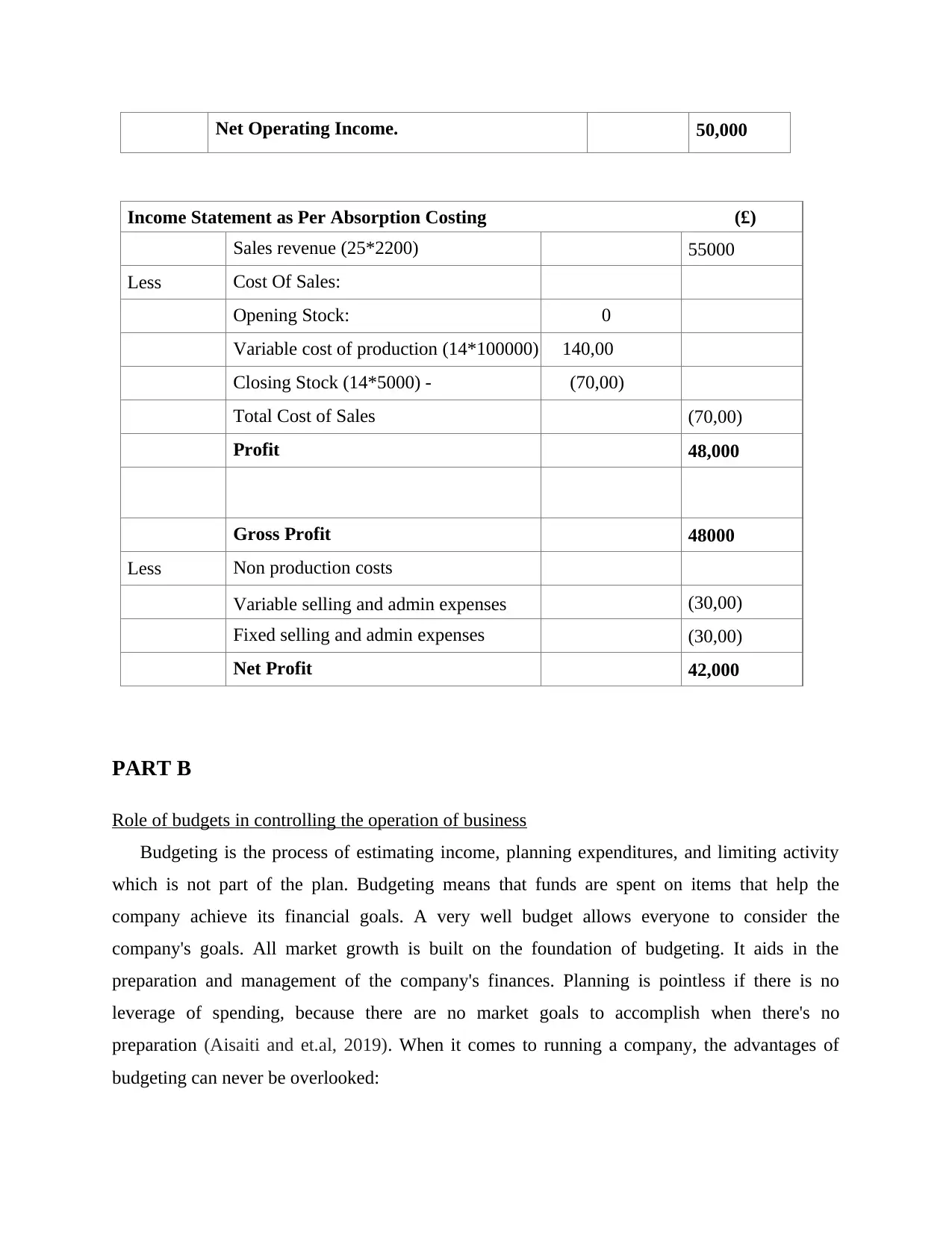
Net Operating Income. 50,000
Income Statement as Per Absorption Costing (£)
Sales revenue (25*2200) 55000
Less Cost Of Sales:
Opening Stock: 0
Variable cost of production (14*100000) 140,00
Closing Stock (14*5000) - (70,00)
Total Cost of Sales (70,00)
Profit 48,000
Gross Profit 48000
Less Non production costs
Variable selling and admin expenses (30,00)
Fixed selling and admin expenses (30,00)
Net Profit 42,000
PART B
Role of budgets in controlling the operation of business
Budgeting is the process of estimating income, planning expenditures, and limiting activity
which is not part of the plan. Budgeting means that funds are spent on items that help the
company achieve its financial goals. A very well budget allows everyone to consider the
company's goals. All market growth is built on the foundation of budgeting. It aids in the
preparation and management of the company's finances. Planning is pointless if there is no
leverage of spending, because there are no market goals to accomplish when there's no
preparation (Aisaiti and et.al, 2019). When it comes to running a company, the advantages of
budgeting can never be overlooked:
Income Statement as Per Absorption Costing (£)
Sales revenue (25*2200) 55000
Less Cost Of Sales:
Opening Stock: 0
Variable cost of production (14*100000) 140,00
Closing Stock (14*5000) - (70,00)
Total Cost of Sales (70,00)
Profit 48,000
Gross Profit 48000
Less Non production costs
Variable selling and admin expenses (30,00)
Fixed selling and admin expenses (30,00)
Net Profit 42,000
PART B
Role of budgets in controlling the operation of business
Budgeting is the process of estimating income, planning expenditures, and limiting activity
which is not part of the plan. Budgeting means that funds are spent on items that help the
company achieve its financial goals. A very well budget allows everyone to consider the
company's goals. All market growth is built on the foundation of budgeting. It aids in the
preparation and management of the company's finances. Planning is pointless if there is no
leverage of spending, because there are no market goals to accomplish when there's no
preparation (Aisaiti and et.al, 2019). When it comes to running a company, the advantages of
budgeting can never be overlooked:
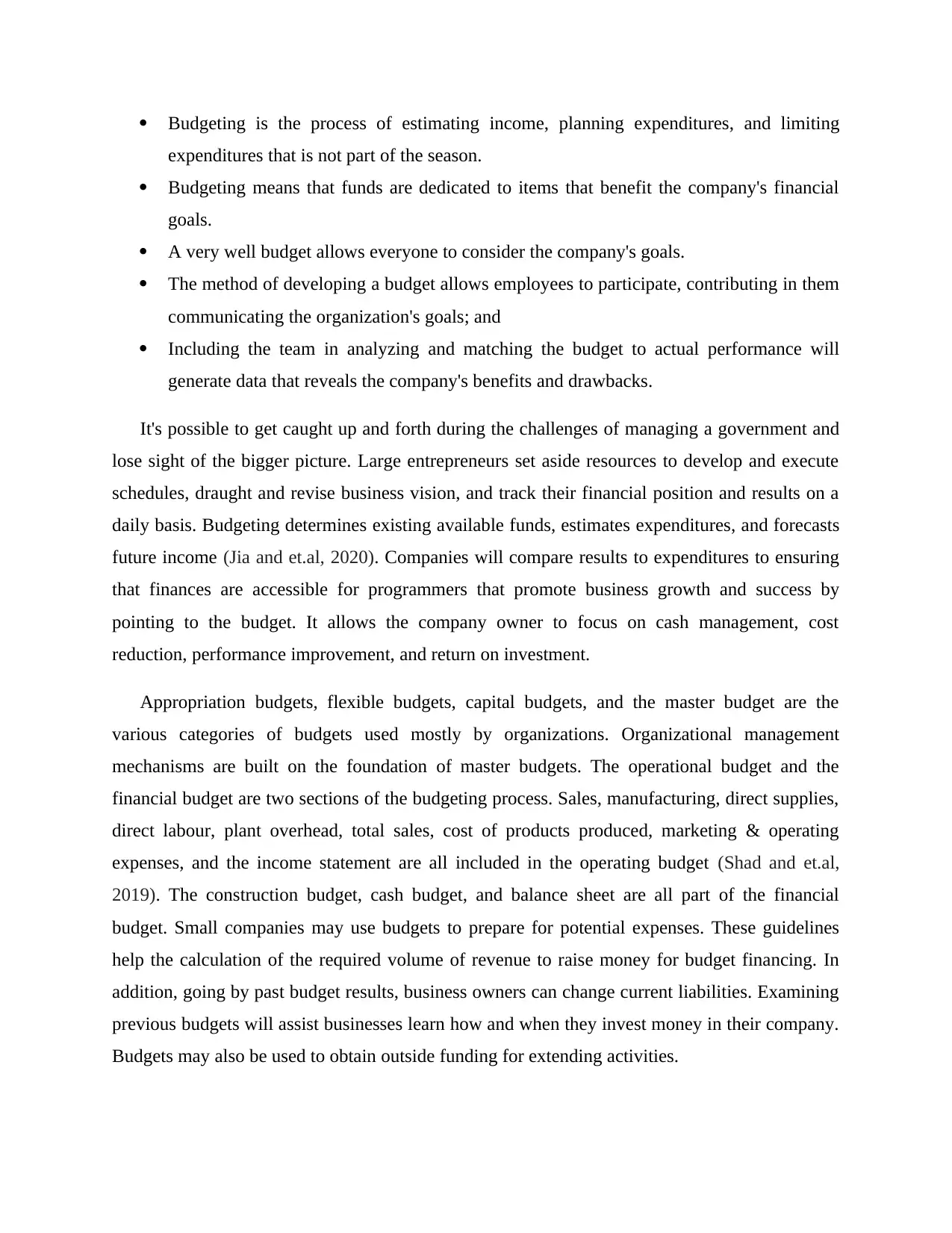
Budgeting is the process of estimating income, planning expenditures, and limiting
expenditures that is not part of the season.
Budgeting means that funds are dedicated to items that benefit the company's financial
goals.
A very well budget allows everyone to consider the company's goals.
The method of developing a budget allows employees to participate, contributing in them
communicating the organization's goals; and
Including the team in analyzing and matching the budget to actual performance will
generate data that reveals the company's benefits and drawbacks.
It's possible to get caught up and forth during the challenges of managing a government and
lose sight of the bigger picture. Large entrepreneurs set aside resources to develop and execute
schedules, draught and revise business vision, and track their financial position and results on a
daily basis. Budgeting determines existing available funds, estimates expenditures, and forecasts
future income (Jia and et.al, 2020). Companies will compare results to expenditures to ensuring
that finances are accessible for programmers that promote business growth and success by
pointing to the budget. It allows the company owner to focus on cash management, cost
reduction, performance improvement, and return on investment.
Appropriation budgets, flexible budgets, capital budgets, and the master budget are the
various categories of budgets used mostly by organizations. Organizational management
mechanisms are built on the foundation of master budgets. The operational budget and the
financial budget are two sections of the budgeting process. Sales, manufacturing, direct supplies,
direct labour, plant overhead, total sales, cost of products produced, marketing & operating
expenses, and the income statement are all included in the operating budget (Shad and et.al,
2019). The construction budget, cash budget, and balance sheet are all part of the financial
budget. Small companies may use budgets to prepare for potential expenses. These guidelines
help the calculation of the required volume of revenue to raise money for budget financing. In
addition, going by past budget results, business owners can change current liabilities. Examining
previous budgets will assist businesses learn how and when they invest money in their company.
Budgets may also be used to obtain outside funding for extending activities.
expenditures that is not part of the season.
Budgeting means that funds are dedicated to items that benefit the company's financial
goals.
A very well budget allows everyone to consider the company's goals.
The method of developing a budget allows employees to participate, contributing in them
communicating the organization's goals; and
Including the team in analyzing and matching the budget to actual performance will
generate data that reveals the company's benefits and drawbacks.
It's possible to get caught up and forth during the challenges of managing a government and
lose sight of the bigger picture. Large entrepreneurs set aside resources to develop and execute
schedules, draught and revise business vision, and track their financial position and results on a
daily basis. Budgeting determines existing available funds, estimates expenditures, and forecasts
future income (Jia and et.al, 2020). Companies will compare results to expenditures to ensuring
that finances are accessible for programmers that promote business growth and success by
pointing to the budget. It allows the company owner to focus on cash management, cost
reduction, performance improvement, and return on investment.
Appropriation budgets, flexible budgets, capital budgets, and the master budget are the
various categories of budgets used mostly by organizations. Organizational management
mechanisms are built on the foundation of master budgets. The operational budget and the
financial budget are two sections of the budgeting process. Sales, manufacturing, direct supplies,
direct labour, plant overhead, total sales, cost of products produced, marketing & operating
expenses, and the income statement are all included in the operating budget (Shad and et.al,
2019). The construction budget, cash budget, and balance sheet are all part of the financial
budget. Small companies may use budgets to prepare for potential expenses. These guidelines
help the calculation of the required volume of revenue to raise money for budget financing. In
addition, going by past budget results, business owners can change current liabilities. Examining
previous budgets will assist businesses learn how and when they invest money in their company.
Budgets may also be used to obtain outside funding for extending activities.
⊘ This is a preview!⊘
Do you want full access?
Subscribe today to unlock all pages.

Trusted by 1+ million students worldwide
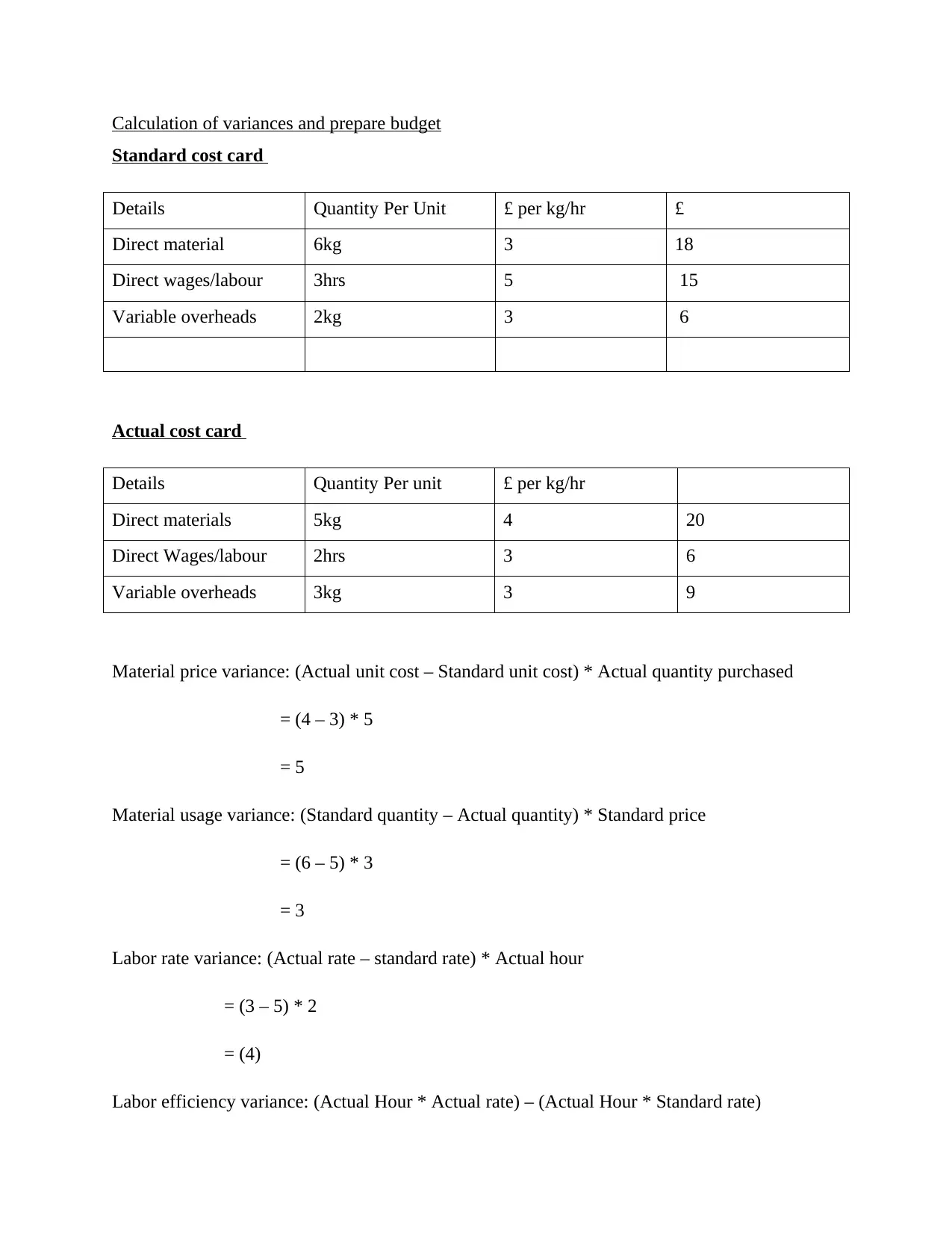
Calculation of variances and prepare budget
Standard cost card
Details Quantity Per Unit £ per kg/hr £
Direct material 6kg 3 18
Direct wages/labour 3hrs 5 15
Variable overheads 2kg 3 6
Actual cost card
Details Quantity Per unit £ per kg/hr
Direct materials 5kg 4 20
Direct Wages/labour 2hrs 3 6
Variable overheads 3kg 3 9
Material price variance: (Actual unit cost – Standard unit cost) * Actual quantity purchased
= (4 – 3) * 5
= 5
Material usage variance: (Standard quantity – Actual quantity) * Standard price
= (6 – 5) * 3
= 3
Labor rate variance: (Actual rate – standard rate) * Actual hour
= (3 – 5) * 2
= (4)
Labor efficiency variance: (Actual Hour * Actual rate) – (Actual Hour * Standard rate)
Standard cost card
Details Quantity Per Unit £ per kg/hr £
Direct material 6kg 3 18
Direct wages/labour 3hrs 5 15
Variable overheads 2kg 3 6
Actual cost card
Details Quantity Per unit £ per kg/hr
Direct materials 5kg 4 20
Direct Wages/labour 2hrs 3 6
Variable overheads 3kg 3 9
Material price variance: (Actual unit cost – Standard unit cost) * Actual quantity purchased
= (4 – 3) * 5
= 5
Material usage variance: (Standard quantity – Actual quantity) * Standard price
= (6 – 5) * 3
= 3
Labor rate variance: (Actual rate – standard rate) * Actual hour
= (3 – 5) * 2
= (4)
Labor efficiency variance: (Actual Hour * Actual rate) – (Actual Hour * Standard rate)
Paraphrase This Document
Need a fresh take? Get an instant paraphrase of this document with our AI Paraphraser
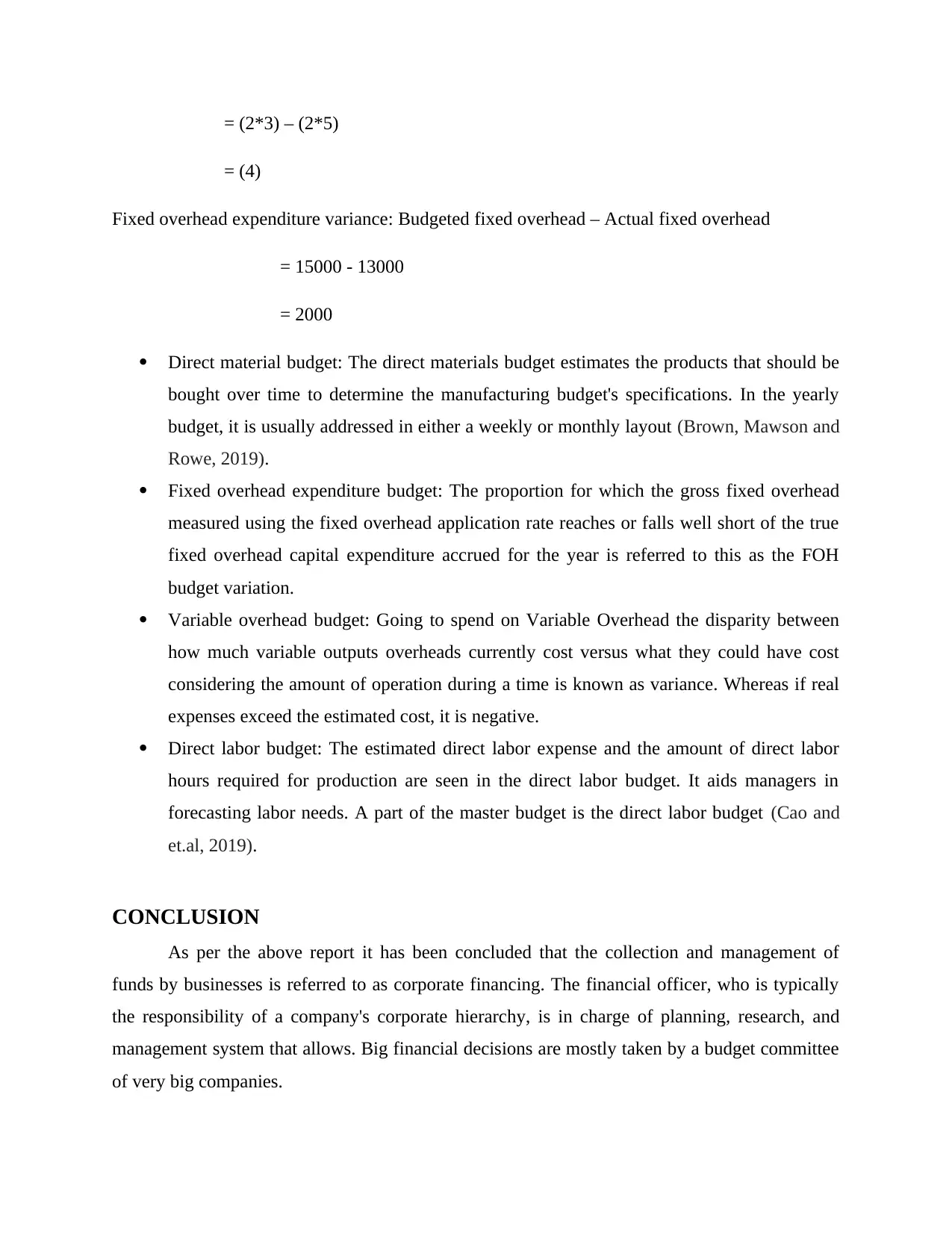
= (2*3) – (2*5)
= (4)
Fixed overhead expenditure variance: Budgeted fixed overhead – Actual fixed overhead
= 15000 - 13000
= 2000
Direct material budget: The direct materials budget estimates the products that should be
bought over time to determine the manufacturing budget's specifications. In the yearly
budget, it is usually addressed in either a weekly or monthly layout (Brown, Mawson and
Rowe, 2019).
Fixed overhead expenditure budget: The proportion for which the gross fixed overhead
measured using the fixed overhead application rate reaches or falls well short of the true
fixed overhead capital expenditure accrued for the year is referred to this as the FOH
budget variation.
Variable overhead budget: Going to spend on Variable Overhead the disparity between
how much variable outputs overheads currently cost versus what they could have cost
considering the amount of operation during a time is known as variance. Whereas if real
expenses exceed the estimated cost, it is negative.
Direct labor budget: The estimated direct labor expense and the amount of direct labor
hours required for production are seen in the direct labor budget. It aids managers in
forecasting labor needs. A part of the master budget is the direct labor budget (Cao and
et.al, 2019).
CONCLUSION
As per the above report it has been concluded that the collection and management of
funds by businesses is referred to as corporate financing. The financial officer, who is typically
the responsibility of a company's corporate hierarchy, is in charge of planning, research, and
management system that allows. Big financial decisions are mostly taken by a budget committee
of very big companies.
= (4)
Fixed overhead expenditure variance: Budgeted fixed overhead – Actual fixed overhead
= 15000 - 13000
= 2000
Direct material budget: The direct materials budget estimates the products that should be
bought over time to determine the manufacturing budget's specifications. In the yearly
budget, it is usually addressed in either a weekly or monthly layout (Brown, Mawson and
Rowe, 2019).
Fixed overhead expenditure budget: The proportion for which the gross fixed overhead
measured using the fixed overhead application rate reaches or falls well short of the true
fixed overhead capital expenditure accrued for the year is referred to this as the FOH
budget variation.
Variable overhead budget: Going to spend on Variable Overhead the disparity between
how much variable outputs overheads currently cost versus what they could have cost
considering the amount of operation during a time is known as variance. Whereas if real
expenses exceed the estimated cost, it is negative.
Direct labor budget: The estimated direct labor expense and the amount of direct labor
hours required for production are seen in the direct labor budget. It aids managers in
forecasting labor needs. A part of the master budget is the direct labor budget (Cao and
et.al, 2019).
CONCLUSION
As per the above report it has been concluded that the collection and management of
funds by businesses is referred to as corporate financing. The financial officer, who is typically
the responsibility of a company's corporate hierarchy, is in charge of planning, research, and
management system that allows. Big financial decisions are mostly taken by a budget committee
of very big companies.

⊘ This is a preview!⊘
Do you want full access?
Subscribe today to unlock all pages.

Trusted by 1+ million students worldwide
1 out of 13
Related Documents
Your All-in-One AI-Powered Toolkit for Academic Success.
+13062052269
info@desklib.com
Available 24*7 on WhatsApp / Email
![[object Object]](/_next/static/media/star-bottom.7253800d.svg)
Unlock your academic potential
Copyright © 2020–2025 A2Z Services. All Rights Reserved. Developed and managed by ZUCOL.





